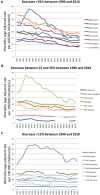Disparities in suicide mortality trends between United States of America and 25 European countries: retrospective analysis of WHO mortality database
- PMID: 26883796
- PMCID: PMC4756707
- DOI: 10.1038/srep20256
Disparities in suicide mortality trends between United States of America and 25 European countries: retrospective analysis of WHO mortality database
Abstract
The objective was to examine changes in temporal trends in suicide mortality in 26 Western countries by retrospective trend analysis of the WHO mortality database on causes of deaths. From 1990 to 2010, there was a median reduction in suicide mortality of 22.7%, ranging from a 46% reduction in Estonia to a 26.2% increase in Romania. Suicide mortality decreased by ≥ 20% in 15 countries, and the reduction tended to be greater in countries with higher mortality in 1990. In most of the central European countries mortality strongly declined. The median changes in the age groups were -25.3% (range -62.9% to 72.6%) in people aged 15-24 years, -36.9% (-60.5% to 32.4%) in 25-34 years, -3.6% (-57.1% to 92%) in 35-54 years, -12.2% (-37% to 65,7%) in 55-74 years and -16.1% (-54.5% to 166.7%) in ≥ 75 years. Suicide prevention programs in youths and in the elderly seem to be effective (at least in females for the elderly) and efforts should be pursued in this way. However, suicide mortality of the people aged 35-54 years has increased in half of the studied countries between 1990 and 2010. Public policies should further orientate their efforts toward this population.
Figures




References
-
- World Health Organization (WHO). Preventing suicide: A global imperative. WHO (2014). at http://www.who.int/mental_health/suicide-prevention/world_report_2014/en/. Accessed 04/12/2015.
-
- World Health Organization (WHO). Figures and facts about suicide. (1999). http://apps.who.int/iris/bitstream/10665/66097/1/WHO_MNH_MBD_99.1.pdf. Accessed 04/12/2015.
-
- Patel V., Flisher A. J., Hetrick S. & McGorry P. Mental health of young people: a global public-health challenge. The Lancet 369, 1302–1313 (2007). - PubMed
-
- Fond G., Brunel L., Leboyer M. & Boyer L. Do the treasures of ‘big data’ combined with behavioural intervention therapies contain the key to the mystery of large psychiatric issues? Acta Psychiatr. Scand. 130, 406–407 (2014). - PubMed
Publication types
MeSH terms
LinkOut - more resources
Full Text Sources
Other Literature Sources
Medical

